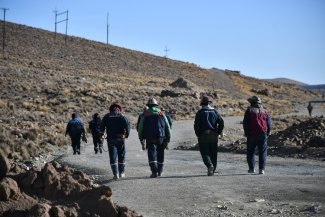Coal miners exit the mine shaft after their shift on 25 September, 2018 at the Kapitalnaya mine in the city of Dimitrov, renamed Myrnograd in 2016 following a policy of “decommunisation” initiated by Ukraine after the events of 2014 and 2015.
For the fourth consecutive month, 37-year old miner Vladimir Kozlov has not received his salary. Neither has his wife Natacha, who is in charge of distributing equipment to the miners at the same mine where her husband digs tunnels 100 metres underground in stifling heat. Both are employees of the Kapitalnaya coal mine, which belongs to the Ukrainian state. In order to make ends meet, these young parents of an eight-year old girl have taken out a loan from the bank, borrowed money from the meagre pension that Vladimir’s parents receive and grow their own food in the garden surrounding the modest, two-room house that they built with their own hands.
Although he worries about the onset of winter and the hardships it will bring, Vladimir remains hopeful that the government will release his wages soon. Like all of his co-workers, he continues to show up for work every day. “We don’t have any other choice – there are no other jobs here,” he explains. Miners also earn at least twice the average wage (around €180), making them even more reluctant to abandon their profession.
The Kapitalnaya mine, which now employs 2,700 people – down from 9,000 at the end of the Soviet era – is still the primary employer for most of the families in the city of Myrnograd, located about 50 kilometres from Donetsk in the Donbass region of eastern Ukraine.
During the Soviet era, Kapitalnaya was known as Stakhanov. “It used to be the largest mine in Europe,” reminisces Alexander Abramov while standing in front of an empty pedestal that once held the triumphant statue of Alexey Stakhanov, the Soviet miner hero who became famous for breaking productivity records and whose name gave rise to the term “Stakhanovism,” which was synonymous with hard work.
“We want to put up a monument to ordinary miners,” adds Abramov, a trade unionist from The Independent Trade Union of Miners (NPGU), before taking us to visit the mine. State-of-the-art when it opened in 1974, the site has now fallen into disrepair, with 80 per cent of its equipment out of use or obsolete.
At the mine’s headquarters, roughly 15 team leaders listen to the foreman’s instructions before their shift begins. Their features are gaunt, their faces stoic. “We’ve never had any fatal accidents here,” explains the foreman after taking the register. “But conditions are increasingly difficult. Soon we’ll have to work like our grandfathers did – with hammers!” Despite everything, all of the miners have shown up for work once again.
There was a time when salaries in the Donbass mining region were the highest in the Soviet Union, attracting workers from far and wide. After the Union collapsed and Ukraine gained its independence, thousands of mines and industrial sites were hit by a wave of privatisation. “All of the most profitable sites are now in the hands of private groups. Eighty-five per cent of them are held by the DTEK holding company, which is owned by local oligarch Rinat Akhmetov. The least profitable ten per cent remained property of the state,” explains Andrey Gerus, a Ukrainian economist specialising in the energy sector. According to Gerus, the costs of production for coal in the public sector are now two to ten times higher than in the private sector. “These mines are losing money and the most logical step would be to close them,” he says.
Working for less than a kopeck
But the Kapitalnaya mine can produce good coal “for another 50 to 60 years,” insists Abramov. “We don’t want the mine to close. It would mean the end of employment for everyone here. Young people can go abroad, but those who have been working in the industry for 10 years are in poor health. We can always apply to DTEK, but they don’t have many openings,” he stresses. The workers aren’t opposed to private takeover of the mine – they know that their working conditions would likely improve – but faced with the immense cost of the site’s needed modernisation, buyers are hard to find.
As state-owned coal mines have gradually been abandoned for 20 years – only about 30 now remain – trade unions have focused their efforts on the non-payment of their workers’ salaries, which has become increasingly common in recent years. In mid-September, representatives of local independent trade unions from all over Ukraine met in Kiev to demand their salaries. A representative of the minster assured they would be paid, but gave no indication of when or how much. As it happened, the payments were made in installments (30 to 60 per cent depending on the case), and only after national demonstrations in July and a series of isolated protests. One such incident occurred on 16 August when five miners refused to come above ground at the end of their shift after learning that a promised payment from the ministry would be devoted to paying off suppliers rather than their salaries.
In a packed room overlooking Maidan square, representatives of some 50,000 workers list the difficulties experienced in their mines. Many of the sites have outstanding debts and electricity has been cut off. “Right now we’re working by torchlight and soon we’ll stop working altogether. You’ll see this winter when everybody runs out of coal,” a trade unionist angrily tells a stone-faced ministry representative.
President of the Confederation of Free Trade Unions of Ukraine (KVPU) Mikhailo Volynets has had a long and eventful career as a trade unionist. The former miner has been involved in many struggles, from the creation of the first free trade unions during Ukraine’s independence in the 1990s to the 2014 Ukrainian revolution. At the end of the meeting he confides: “For months there have been demonstrations, strikes, even hunger strikes and attempts at immolation. But we don’t know what to do next. The ministry truly wants nothing to do with us.”
For several years now, the trade unions have had difficulty ensuring that workers’ rights are enforced. They oppose a new draft Labour Code, adopted at first reading in 2017, which could enter into force if adopted at second reading. To make matters worse, the conflict in eastern Ukraine has resulted in an economic crisis that has hit the industrial sector particularly hard.
In the Donbass, close to half of the mines and factories fell under control of the “People’s Republics” of Donetsk and Louhansk, two proto-states that declared independence in 2014. As a result, trade unions lost up to 60 per cent of their members and with them a significant share of their resources. At the peak of the conflict, mines were destroyed, trade unionists were kidnapped and many people were displaced, creating a complex humanitarian situation.
In Kapitalnaya, only a few kilometres from the ‘contact zone’, the miners are reluctant to discuss politics, even though the yellow and blue of the Ukrainian flag are now once again visible everywhere, having been repainted on towers, wells, utility poles, streetlights and sentry boxes. The conflict – far from being resolved, despite ceasefire agreements – has cost the state a lot of money. “Public funds are flowing into defence instead of the economy,” complains Abramov, expressing the anger of many miners in the east who feel subjected to the double sacrifice of the war and its economic fallout.
Endemic corruption
In the 1990s, miners represented an important socio-political force in Ukraine capable of paralysing the country, as they did during the strikes of 1993; today, they struggle to make their voices heard. In addition to geopolitical and economic developments, the sector has also become divided between private and state-owned companies, where there are significant differences in working conditions.
The monopolisation of the mining industry also plays a role in the plight of workers for state-owned companies who have not received their salaries. The industry is largely under the control of one of the richest men in the country, businessman and former MP Rinat Akhmetov, who has the resources – and political connections – to influence industrial policy in his favour. “Coal prices are based on the ‘Rotterdam Plus’ index. This high index is currently very favourable to DTEK, which can easily make profits, while state-owned coal mines are unable to cover their production costs,” explains Andriy Gerus to Equal Times, who was the first to expose allegations of corruption against the National Energy Regulatory Commission, now under investigation by the National Anti-Corruption Bureau of Ukraine (NABU).
But corruption is not limited to the highest spheres of influence. According to Gerus, “It is present at every level, from the Ministry all the way down, from coal mining to power generation. It comes in the form of overbilling, calls for tenders that are not carried out in a transparent manner, and so on,” he explains. “But corruption is difficult to prove. A lot of money in public companies is diverted, including money destined for salaries.”
In early October, the backlog of wages owed to the miners, some dating as far back as 2015, amounted to over a billion hryvnias (35 millions USD). On 4 October, Prime Minister Volodymyr Groysman announced that 136 million hryvnias would be released for payment of these salaries.
Volynets of the KVPU welcomes this gesture but is waiting to see if the money will make it into the pockets of the workers – without delay and in its entirety. Far from being satisfied with this announcement, miners in the east have continued to protest by blocking roads. Since 19 October, about 15 miners in the Luhansk region have started a new underground strike under extreme conditions. After 13 days, and following a visit from a government representative, Ukrainian president Petro Poroshenko reacted by contacting Volynets to discuss the situation.
Even if the salaries are paid before winter, the future remains bleak for coal miners working for state-owned mines, which continue to lose money even as the price of coal rises. The situation currently appears to be at an impasse, with the government of Petro Poroshenko playing for time to avoid the social and economic fallout of massive closures of state-owned mines – which would likely lead to political destabilisation in the Donbass, where tensions continue to simmer.
The investment plans demanded by workers are unlikely to be implemented before the elections in March and October of 2019 – or as long as the conflict persists. Moreover, Ukraine will have to eventually phase out the use of coal if it wishes to adapt to the transition underway in other industrialised countries.
The men of the Kozlov family have been miners for generations. But Vladimir supports his younger brother’s decision to study journalism at university. He doesn’t want him to face the same fate of many families in the region, who wait in fear that their way of life will soon vanish, all while doing their best to survive.










